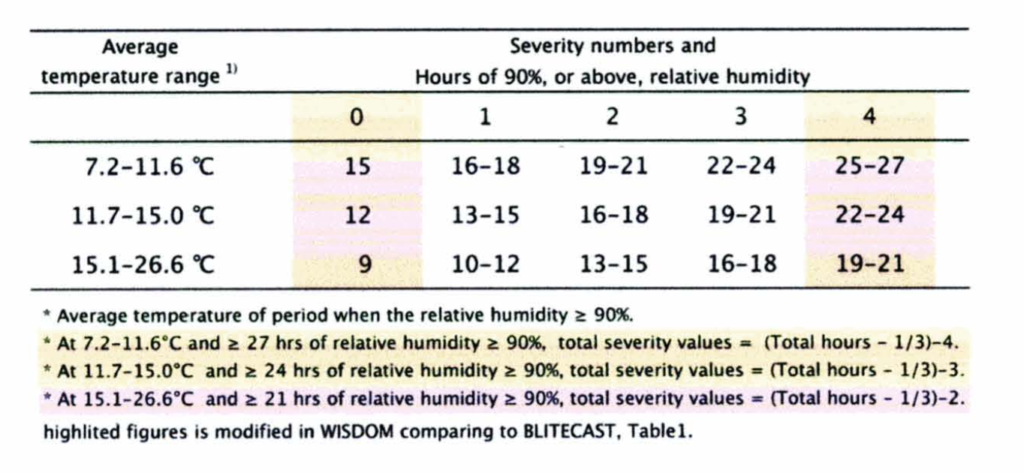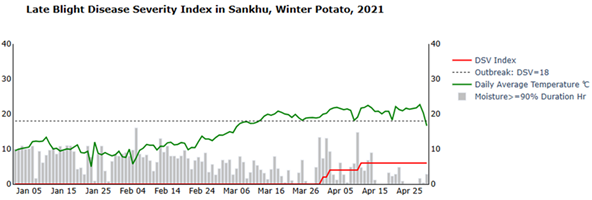3. BLITECAST Prediction of Epidemic Disease First Break Date
In October 2018, the Agricultural Development Institute installed an Field Monitoring System, automated weather observation field server 5) in Sankhu and began a demonstration to search for the first day of the epidemic. It took some time to deal with issues such as the quality of locally-sourced batteries and the quality of communications before we were able to obtain continuous and complete hourly weather data, but in 2021, we installed an improved device and, thanks to the fact that the communications standard in Sankhu was upgraded to 4G, we are now able to use weather data every 10 minutes in the cloud.
In Europe and America, university extension centers disseminate information on the risk of epidemics due to favorable weather conditions and share this information over a wide area network to prevent pandemics from occurring. Since 1975, many computer-based disease forecasting systems have been developed that use seasonal environmental data, relying on the literature of Hyre and Wallin. They aim to reduce unnecessary fungicide spraying by warning farmers when the weather is suitable for disease outbreaks, so that they can time pesticide spraying more appropriately. In United States, BLITECAST was developed, and this accelerated the provision of information to farmers. This has since developed into the WISDOM model, which is modified according to the irrigation level and pesticide application method in the region.
WISDOM is based on BLITECAST. As shown in Table 1, BLITECAST quantifies the climatically favorable conditions for disease outbreaks based on the duration of 90% relative humidity or higher and the average temperatures during that period (severity value), and the cumulative value (DSV) of 18 is the danger date for the first disease outbreak. This danger date is the time for the first application of pesticides. Next, the pesticide application interval after the first application is determined based on Hyre’s rainfall criterion (Table 2).
Table.1 Adjustable matrix used to relate severity values (Wallin’s system) for BlLITECAST

Table. 2 WISDOM fungicide spray interval recommendations; adapted from Fry (1978)

The following section describes the results of the prediction of the date of the first epidemic in 2021 as a case study. Note that summer potatoes will be used as seed potatoes for winter potato, so the analysis will be divided into the period from September to December 2021 and the period from January 2022.
5) Nexag (https://www.sddgrp.co.jp/business/cloud/nexag/). With the cooperation of the developer of Nexag, we implemented an enhanced backup program for data transmission, substituted 12v automotive batteries, and took measures to prevent field mice from eating lead wires and so on.
Summer Potato
At the Kalimati vegetables wholesale market in Kathmandu, wholesale prices of potatoes were higher after November, when the number of international trekkers and tourists increased in the 1990’s, this seasonal price spike triggered an increase in potato production in and around Kathmandu. In recent years, imports from India have increased and seasonal fluctuations in prices have decreased, but summer potato remains an important source of cash income for small farmers.
Figure 3 shows the results of DSV calculated by BLITECAST 6) for different emergence dates. The average daily temperatures and the number of hours with relative humidity above 90% are shown for reference.
In upstream areas, seed potatoes can be planted immediately after rice harvest in late August. Sunlit seed potatoes emergent about one week after planting, and if emergent on September 1, DSV will exceed 18 two weeks later on September 15, reaching the first danger date of disease outbreak. The DSV of the emergence on September 10, September 20, and September 30 is shown in DSV_10, DSV_20, and DSV_30, respectively. The high relative humidity and high average temperatures during September indicate a high risk of epidemic disease in summer potatoes. If the date of seed potato emergence is set for September 30, it will take about a month for the DSV to reach 18, which will considerably lower the risk of blight epidemic. If seed potatoes are planted even later, in October, the risk of disease outbreak is even lower. However, although the risk of blight is reduced, another risk arises: the possibility of frost damage due to low temperatures.
The results of predicting the lesion onset at different seed potato planting times indicate that summer potato is generally at high risk for epidemic disease. If preventing the onset of epidemic disease were the top priority goal, then by delaying the planting time of summer potato plants by 30 days, the DSV would never reach 18 and there would be no need to use pesticides. Therefore, delaying the production period of summer potato squash throughout the region would also be an option. Since summer potatoes are also used as seed potatoes for winter potatoes, this could be an option from a quality perspective.

Fig. 3. Late Blight Disease Severity- in Summer Potatoes, by planting date, 2021
Winter Potato
In the upper zone I, winter potato can be planted in mid-December. In this case, it is important to avoid early frost damage at the time of emergence and early growth. Usually, emergence occurs in early January in the upper reaches of the river and in early February in the middle reaches. The DSV never exceeds 18 during the winter potato production period, indicating that there is little potential for weather factors to cause a potato blight outbreak. However, further research is needed on 7.2°C conditions.

Fig. 4 Late Blight Disease Severity- in Winter Potato, 2021
As described above, the climatically favorable conditions for epidemic disease are very different between summer and winter potatoes. The results for other years were the same as for 2021, so we can conclude that the possibility of an outbreak of disease due to weather conditions is high for summer potatoes and low for winter potatoes.
6) For the Python program used for prediction on lesion onset by BLITECAST, see Agricultural Development Research Group (2022).